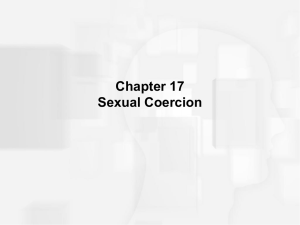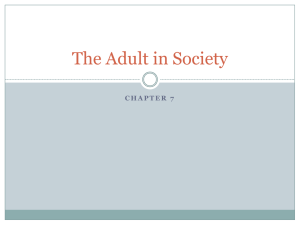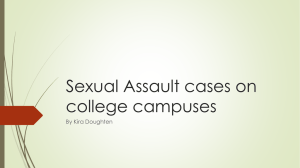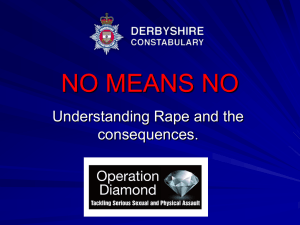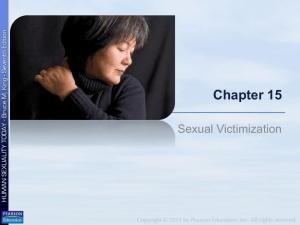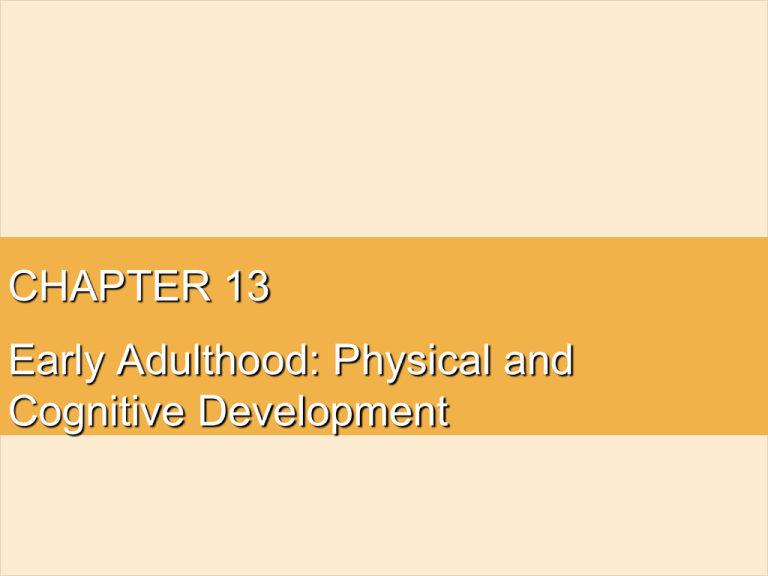
CHAPTER 13
Early Adulthood: Physical and
Cognitive Development
Emerging Adulthood
Emerging Adulthood
• Emerging adulthood
– Distinct period of development that is found in societies that
allow young people an extended opportunity to explore their
roles in life
– These societies tend to be affluent; parents or government help
with higher education
– However, some people cannot gain the necessary supports to
successfully travel into emerging adulthood
– Adults in this stage report maturity in some areas but not in
others.
Physical Development
Physical Development
• Physical development peaks in early adulthood.
– (20’s and early 30’s) then declines
• Sensory sharpness peaks in early 20’s and then begins gradual
decline in middle adulthood
• Visual acuity remains good until middle adulthood.
– Decline leads to farsightedness and a need for reading glasses
• Hearing decline beginning in late 20’s/early 30’s
Physical Development (cont’d)
• Changes in cardiovascular, respiratory, and immune
systems gradually begin to decline.
– Regular exercise can increase cardiovascular and respiratory
capacity.
– As people age, the immune system produces fewer white blood
cells and the disease-fighting ability of those that remain
declines.
Physical Development (cont’d)
• Fertility decreases as both sexes age.
Women
– After age 35, pregnant women are checked for Down
syndrome and chromosomal abnormalities.
– Number of eggs in women are reduced and the
quality is not as good
– May still have healthy children into their 40’s
Men
– Older men may contribute to infertility as well.
Physical Development (cont’d)
• Both sexes may be graying and losing hair by end of
early adulthood
– Due to heredity, men may bald by mid 20’s.
• Skin may begin to loosen, grow less elastic, and wrinkle
– More so in women than in men
Health and Fitness
Health and Fitness
• Young adults tend to have healthy immune systems.
• Accidents most prominent reason for early death
– Further declines among 25- to 44-year-olds
• Homicide accounts for 13.9% of deaths of 25- to 44year-old men.
– Does not decline until 40 to 65 years of age
• Cancer and heart disease kill a much larger percentage
of people aged 25 to 44 than aged 15 to 24, but they
take second and third place behind accidents
• HIV/AIDS becomes leading cause of death among 25to 44-year-olds
Health and Fitness (cont’d)
• Many young adults do not take care of health and put it
on “back burner”
– 78% of young adults eat less fruits and vegetables than
recommended
– 43% engage in no physical activity
– 29% are smokers
– 30% engage in binge drinking
– 26% are overweight
– 14% are obese
(McCracken et al., 2007)
Diet and Weight
• Females more likely than males to report dieting
• Being overweight runs in families.
– Strong heredity role
• Adaptive thermogenesis may sabotage weight loss
efforts.
• Psychological factors
– Observational learning, stress, and emotional states contribute to
obesity.
Fig. 13-2, p. 270
Exercise
• Adults 18+ need 30 minutes of physical activity five or
more days a week.
– Breaking exercise into smaller segments is beneficial
• Reduces risk of developing or dying from
– cardiovascular disease
– type 2 diabetes
– certain cancers such as colon
• Exercise helps lower blood pressure and cholesterol,
prevents or retards osteoporosis and arthritis, and
reduces obesity.
– Benefits brain function and helps with some mental disorders
• Integrating exercise into daily routine best way
Substance Abuse and Dependence
• Substance abuse
– Ongoing use of a substance despite the social, occupational,
psychological, or physical problems it causes (APA, 2000)
• Substance dependence
– Having the substance in the body becomes a norm
• Tolerance
– Body becomes habituated to a certain amount and needs more
to achieve same effect
• Abstinence syndrome
– Withdrawal symptoms when dosage is lowered
Effects of Depressants
• Depressants slow the nervous system.
– Include alcohol, narcotics derived from the opium poppy
(heroine, morphine, and codeine), and sedatives (barbiturates
and methaqualone)
• Alcohol effects
– Lowers inhibitions
– Binge drinking associated with bad grades and risky behavior
such as unprotected sex, acts of aggression
– Distorts perceptions, impairs concentration
• Alcohol use most prevalent among 21- to 34-year-olds
– Over 2 million college students a year drive under the influence
of alcohol.
– More than one million between the ages of 18 to 24 are
accidentally injured while under the influence.
Effects of Depressants (cont’d)
• Barbiturates are addictive.
– In part due to their legitimate medical uses
• They are abused due to
– relaxing effects
– mild euphoric effects
Effects of Stimulants
• Stimulants increase central nervous system activity
– Nicotine, cocaine, and amphetamines most common
• Nicotine
– Addictive chemical in tobacco
• 450,000 Americans die from smoking-related problems
each year.
• Cigarette smoke contains carbon monoxide.
• Shortness of breath
• Hydrocarbons that cause respiratory diseases and lung cancer
Effects of Stimulants (cont’d)
• Cocaine produces feelings of euphoria, relieves pain,
boosts self-confidence, reduces the appetite
• Cocaine
–
–
–
–
–
accelerates heart rate
spikes the blood pressure
constricts arteries of heart
thickens blood
can cause cardiovascular and respiratory collapse
• Cocaine overdoses can causes restlessness, insomnia,
tremors, and death.
Effects of Stimulants (cont’d)
• Tolerance for amphetamines develops quickly.
• Methamphetamine may be physically addictive.
– High doses can cause restlessness and insomnia, irritability, and
loss of appetite
• Methamphetamine abuse can cause brain damage,
leading to problems with learning and memory.
– Smoking or injecting it can be associated with violent behavior
Effects of Hallucinogenics
• Hallucinogenics contribute to perceptual distortions
called hallucinations.
• Marijuana, Ecstasy, LSD, and PCP are hallucinogenics.
• Marijuana
– can be smoked or eaten
– helps users to relax and elevates their mood
– provides greater sensory awareness, self-insight, creativity, and
empathy for others
– increases attunement to bodily sensations
– visual hallucinations as in time slowing down occurs
– strong intoxication frightens some smokers
Effects of Hallucinogenics (cont’d)
• Marijuana health risks
– Impaired perceptual-motor coordination, short-term memory, and
slows learning
– Regular users may experience withdrawal, which is a sign of
addiction
• Ecstasy (MDMA)
–
–
–
–
Popular party drug; chemical formula similar to amphetamines
Boosts self-confidence; alertness and elation increased
Mild hallucinogenic
Decreases inhibitions, which can result in risky behavior such as
unprotected sex
– Impairs working memory, increases anxiety, and can lead to
depression
Effects of Hallucinogenics (cont’d)
• LSD (lysergic acid diethylamide)
– Hallucinogenic drug
– Can impair coordination and judgment, change mood,
and cause hallucinations and paranoid delusions
Stress and Health
• One-third of Americans report living with “extreme
stress”. (APA, 2012)
• Stress negatively affects
– psychological and physical health
– social, academic, and vocational lives
• Younger adults respond to stress in unhealthy ways.
– Skipping meals, lying awake at night, smoking more when
stressed
Stress Management Tips
• Get in touch with the ways you experience stress
• Identify stressors such as people and situations.
• Get in touch with the way you handle or don’t handle
stress.
• Work on creating better ways to cope with stress.
• Take care of your health.
• Obtain social support
Sexuality
Sexuality
• Sexual activity peaks in early 20’s
• Sexual frequency may be due to surge of hormones and
opportunity.
• Men and women are still experiencing the flood of sex
hormones that affected them as adolescents
Sexually Transmitted Infections (STIs)
• Chlamydia
– Most commonly occurring STI in young adults
followed by gonorrhea, genital warts, genital herpes,
syphilis, and HIV/AIDS
• 2.8 million new Chlamydia infections occur each
year.
– Major cause of pelvic inflammatory disease (PID),
which oftentimes leads to sterility
Sexually Transmitted Infections (STIs) (cont’d)
• Human Papilloma Virus (HPV)
– Major cause of genital warts and associated with cervical cancer
– 6 million new cases of HPV each year in the U.S.
– Estimated that 50% of men and women contract HPV at some
time in their lives
– A vaccine is available that prevents most young women from
being infected
• Genital warts not visible on the cervix in women or in the
urethra in men
• Greatest risk
– Women initiating sex prior to age 18 and engaging with multiple
partners
Sexually Transmitted Infections (STIs) (cont’d)
• HIV/AIDS
– Most devastating STI
– If left untreated, is lethal; long-term prospects of those
who do receive treatment unknown
– 33 million people worldwide are living with HIV/AIDS
• 2.5 million are children under the age of 15
– Risk factors
•
•
•
•
•
Anal intercourse
Injecting drugs by sharing needles
Multiple sex partners
Failing to use condoms
Abusing drugs and alcohol
Sexually Transmitted Infections (STIs) (cont’d)
• Women in U.S. less affected by HIV/AIDS, but in other
parts of the world, are more likely to be infected
• European, African, and Southeast Asian sexually active
teenage girls have higher rates of HIV infection than
older women or young men
Table 13-2, p. 276
Menstrual Problems
• 50 to 75% of women experience discomfort prior to or
during menstruation.
• Dysmenorrhea
– Pelvic cramps
– May be brought on by hormones called prostaglandins
– Fluid retention in the pelvic region may cause bloating
• Amenorrhea
– Absence of menstruation and a sign of infertility
– Symptom of anorexia nervosa and extreme exercise
• Premenstrual syndrome (PMS)
– Combination of biological and psychological symptoms affecting
women during the four- to six-day interval preceding
menstruation
Menstrual Problems (cont’d)
• Premenstrual Dysphoric Disorder (PMDD)
– More severe than PMS; a technical term used by American
Psychiatric Association
• Premenstrual symptoms include
– psychological discomfort, muscular tension, aches, or pains;
cause of PMS may be due to body’s responses to changing
levels of estrogen and progesterone; linked with imbalances in
neurotransmitters such as serotonin and GABA
• Treatment includes
– exercise, dietary control, vitamin supplements, hormone
treatments, and medications that reduce anxiety or increase the
activity of serotonin
Rape: The Most Intimate Crime of Violence
• Rape is defined as
– sex with a nonconsenting person by the use of force or the
threat of force
• Women aged 16 to 24
– 2 to 3 times more likely to be raped than girls or older women
• Most states permit prosecution of husbands who rape
their wives
• Statistics
– 1 in 4 U.S. women are raped during lifetime
– 188,000 women assaulted in 2010
– 10% of rape victims are men whose assailants are generally
men
– 2/3 of rapes not reported
Types of Rape
• Acquaintance rape
–
–
–
–
90% of rapes committed by acquaintances of the victim
Includes classmates, coworkers, dates, or family friends
Less likely to be reported to the police
Misunderstood type of rape; may be passed off as lover’s
quarrel
• Date rape
– More likely to occur when there has been too much to drink and
then the couple parks in the male’s car or the female goes to his
residence
Social Attitudes, Myths, and Cultural Factors
that Encourage Rape
• Some attitudes toward rape consist of
– the beliefs that a woman wants a forceful and pushy man
– the way a woman dresses encourages rape
– women want to be overpowered and forced into sex by men
• Society pushes males into socially and sexually
dominant roles by reinforcing males as children for
aggressive and competitive behavior as well as
ostracizing them for “feminine” traits such as tenderness
and empathy, which might restrain aggression
Sexual Harassment
• In the workplace, defined as deliberate or repeated
unwanted comments, gestures, or physical contact
• Make the workplace a hostile environment
• Sexual harassment includes
– sexual jokes, overtures, suggestive comments, verbal abuse,
leering at or ogling a person’s body, unwelcome physical
contact, outright sexual assault
• Includes demands for sex accompanied by threats about
one’s job or student status
Sexual Harassment (cont’d)
• Sexual harassment oftentimes ignored
– The victim may suffer from anxiety, irritability, lower self-esteem,
and anger.
– Some resign from their jobs due to the harassment.
• Some harassers maintain the victim took them too
seriously.
• Has to do with abuse of power more than sexual desire
– Especially true in “male” fields
• Employers are accountable if harassment creates a
hostile or abusive work environment or interferes with an
employee’s work performance.
Cognitive Development
Cognitive Development
• People at height of cognitive ability during early
adulthood
• Improvements
– People retain verbal skills and may improve vocabulary and
general knowledge as they age
– Crystallized intelligence increases with age
• Declines
– Memory shows great decline as we age
– Problem-solving speed and visual-spatial skills decline as we
age.
– Fluid intelligence more likely to decrease with age
Perry’s Theory of Epistemic Cognition
• Epistemic cognition
– Concerns our ideas about how we arrive at our beliefs, facts,
and ideas
• College students’ views on what and how they know
something becomes more complex as they are exposed
to the challenges of college thought.
• College exposure consists of learning material, but also
learning different cultures and backgrounds as well as
different views taught by professors.
• Students move from dualistic thinking to a more
relativistic thinking to commitment as they mature.
Labouvie-Vief’s Theory of Pragmatic Thought
• Pragmatic thought
– Adults must narrow possibilities into choices (Labouvie-Vief,
2006)
• Cognitively healthy adult is more willing to compromise
and cope with the world as it is
• Cognitive-affective complexity
– The harboring of both positive and negative feelings about
career choices, partners (Labouvie-Vief, 2006)
– Adults function best when they can accept reality but choose
goals that allow positive feelings.
Postformal Thinking
• Young adults are less egocentric than adolescents.
• Young adults more relativistic but ideally capable of
making commitments in their relativistic world
• Young adults maintain most of the benefits of their
general secondary education; if gone on to higher
education, they have gained specialized skills
• No scientific agreement if there is a stage past Piaget’s
formal operations
Career Development
Choosing a Career
• Particular occupation may not be chosen until college
years or after
• Most career choices based on experiences and
personalities
– Some follow respected members of the community
– Some young adults postpone career decisions until after college
• Many young adults “fall into” careers due to what is
available at the time, family pressures, or the lure of high
income or a particular lifestyle.
Career Development
• Work provides extrinsic and intrinsic motives.
• Extrinsic motives
– Paycheck, fringe benefits, security
• Intrinsic motives
– Opportunity to engage in stimulating and satisfying activities
– Includes work ethic, self-identity, self-fulfillment, self-worth,
socialization, and public roles
• More women quit their careers due to intrinsic motives.
Super’s Stages of Career Development
• Fantasy stage
– Involves child’s unrealistic conception of self-potential and of the
world of work
– Dominates until age 11
• Tentative choice stage
– From age 11 to 17, focus is on some realistic self-assessment
and knowledge of occupations
– Based on interests, abilities, limitations, and glamour
• Realistic choice stage
– Choices become narrow after age 17 as student weighs job
requirements and rewards against interests, abilities, and values
Super’s Stages of Career Development (cont’d)
• Maintenance stage
– Person settles into career role, which normally occurs in the
second half of our 30s
– Career continues to develop, and there is a feeling of moving
forward
– Job hopping more necessary due to corporate downsizing,
mergers, and acquisitions
– Return to school for different training; may need to occur out of
necessity as well as interest
• Retirement stage
– Individual severs bonds with the workplace; retirees often
undertake second or third careers
Developmental Tasks in a Beginning Career
• Career challenges may include
– learning how to carry out the job tasks
– accepting your subordinate status within the organization or
profession
– learning how to get along with coworkers and supervisor
– showing that you can maintain the job, make improvements, and
show progress
– finding a sponsor or mentor
– defining the boundaries between the job and other areas of life
– evaluating your choice in the light of supervisor appraisal
– measurable outcomes
– learning to cope with the daily stressors




